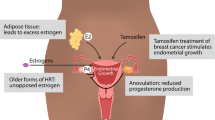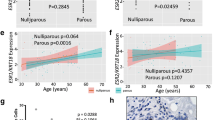Abstract
For the endometrium, estradiol and tamoxifen induce proliferation, and consequently, tamoxifen treatment of breast cancer results in a 2-fold to 7-fold increased risk for endometrial cancer. Here, the role of activation of growth factor receptor signaling in mediating the e fects of estrogen and tamoxifen is determined. Microarray analysis of ECC-1 cells treated with estradiol or tamoxifen indicate that rapid responses to treatment (1 hour) are very distinct from long-term responses (> 24 hours). Furthermore, estradiol and tamoxifen are observed to induce AKT activation. Comparing long-term estrogen- and tamoxifen-regulated genes with genes regulated by insulin-like growth factor 1 and amphiregulin reveals that the late e fects of estrogen and tamoxifen signaling may partly be mediated via activation of growth factor receptor signaling pathways. It is hypothesized that both early and late e fects of estrogen and tamoxifen signaling in the endometrium are partly mediated via the activation of growth factor receptor signaling, putatively at the level of AKT activation.
Similar content being viewed by others
References
Tamoxifen for early breast cancer: an overview of the randomised trials. Early Breast Cancer Trialists’ Collaborative Group. Lancet. 1998;351:1451–1467.
Bergman L., Beelen ML, Gallee MP, Hollema H., Benraadt J., van Leeuwen FE. Risk and prognosis of endometrial cancer after tamoxifen for breast cancer. Comprehensive Cancer Centres’ ALERT Group. Assessment of liver and endometrial cancer risk following tamoxifen. Lancet. 2000;356:881–887.
Buzdar AU, Hortobagyi GN Tamoxifen and toremifene in breast cancer: comparison of safety and efficacy. J Clin Oncol. 1998;16:348–353.
Nilsson S., Makela S., Treuter E., et al. Mechanisms of estrogen action. Physiol Rev. 2001;81:1535–1565.
O’Lone R., Frith MC, Karlsson EK, Hansen U. Genomic targets of nuclear estrogen receptors. Mol Endocrinol. 2004;18: 1859–1875.
Gottlicher M., Heck S., Herrlich P. Transcriptional cross-talk, the second mode of steroid hormone receptor action. J Mol Med. 1998;76:480–489.
Bramley T. Non-genomic progesterone receptors in the mammalian ovary: some unresolved issues. Reproduction. 2003; 125:3–15.
Zhang Z., Kumar R., Santen RJ, Song RX The role of adapter protein Shc in estrogen non-genomic action. Steroids. 2004;69: 523–529.
Filardo EJ, Thomas P. GPR30: a seven-transmembrane-spanning estrogen receptor that triggers EGF release. Trends Endocrinol Metab. 2005;16:362–367.
Vivacqua A., Bonofiglio D., Recchia AG, et al. The G protein—coupled receptor GPR30 mediates the proliferative effects induced by 17beta-estradiol and hydroxytamoxifen in endometrial cancer cells. Mol Endocrinol. 2006;20:631–646.
Giudice LC Growth factors and growth modulators in human uterine endometrium: their potential relevance to reproductive medicine. Fertil Steril. 1994;61:1–17.
Pfeiffer D., Spranger J., Al-Deiri M., et al. mRNA expression of ligands of the epidermal-growth-factor-receptor in the uterus. Int J Cancer. 1997;72:581–586.
Hwa V., Oh Y., Rosenfeld RG The insulin-like growth factor-binding protein (IGFBP) superfamily. Endocr Rev. 1999;20: 761–787.
LeRoith D., Werner H., Neuenschwander S., Kalebic T., Helman LJ The role of the insulin-like growth factor-I receptor in cancer. Ann N Y Acad Sci. 1995;766:402–408.
Wells A. EGF receptor. Int J Biochem Cell Biol. 1999;31:637–643.
Surmacz E., Guvakova MA, Nolan MK, Nicosia RF, Sciacca L. Type I insulin-like growth factor receptor function in breast cancer. Breast Cancer Res Treat. 1998;47:255–267.
Yarden Y. The EGFR family and its ligands in human cancer: signalling mechanisms and therapeutic opportunities. Eur J Cancer. 2001;37(suppl 4):S3–S8.
Gielen SC, Hanekamp EE, Blok LJ, Huikeshoven FJ, Burger CW Steroid-modulated proliferation of human endometrial carcinoma cell lines: any role for insulin-like growth factor signaling? J Soc Gynecol Investig. 2005;12:58–64.
Karas M., Kleinman D., Danilenko M., et al. Components of the IGF system mediate the opposing effects of tamoxifen on endometrial and breast cancer cell growth. Prog Growth Factor Res. 1995;6:513–520.
Kleinman D., Karas M., Roberts CT, et al. Modulation of insulin-like growth factor I (IGF-I) receptors and membrane-associated IGF-binding proteins in endometrial cancer cells by estradiol. Endocrinology. 1995;136:2531–2537.
Gielen SC, Burger CW, Kuhne LC, Hanifi-Moghaddam P., Blok LJ Analysis of estrogen agonism and antagonism of tamoxifen, raloxifene, and ICI182780 in endometrial cancer cells: a putative role for the epidermal growth factor receptor ligand amphiregulin. J Soc Gynecol Investig. 2005;12:e55–e67.
Vendrell JA, Magnino F., Danis E., et al. Estrogen regulation in human breast cancer cells of new downstream gene targets involved in estrogen metabolism, cell proliferation and cell transformation. J Mol Endocrinol. 2004;32:397–414.
Hanifi-Moghaddam P., Sijmons B., Ott MC, et al.The hormone replacement therapy drug tibolone acts very similar to medroxyprogesterone acetate in an estrogen-and progesterone-responsive endometrial cancer cell line. J Mol Endocrinol. 2006; 37:405–413.
Auffray C., Rougeon F. Purification of mouse immunoglobulin heavy-chain messenger RNAs from total myeloma tumor RNA. Eur J Biochem. 1980;107:303–314.
Valk PJ, Verhaak RG, Beijen MA, et al. Prognostically useful gene-expression profiles in acute myeloid leukemia. N Engl J Med. 2004;350:1617–1628.
Bjornstrom L., Sjoberg M. Mechanisms of estrogen receptor signaling: convergence of genomic and nongenomic actions on target genes. Mol Endocrinol. 2005;19:833–842.
Gielen SC, Kuhne LC, Ewing PC, Blok LJ, Burger CW Tamoxifen treatment for breast cancer enforces a distinct gene-expression profile on the human endometrium: an exploratory study. Endocr Relat Cancer. 2005;12:1037–1049.
Zhang H., Pan KH, Cohen SN Senescence-specific gene expression fingerprints reveal cell-type-dependent physical clustering of up-regulated chromosomal loci. Proc Natl Acad Sci U S A. 2003;100:3251–3256.
Migliaccio A., Di Domenico M., Castoria G., et al. Steroid receptor regulation of epidermal growth factor signaling through Src in breast and prostate cancer cells: steroid antagonism action. Cancer Res. 2005;65:10585–10593.
Migliaccio A., Castoria G., Di Domenico M., et al. Crosstalk between EGFR and extranuclear steroid receptors. Ann N Y Acad Sci. 2006;1089:194–200.
Guzeloglu Kayisli O, Kayisli UA, Luleci G., Arici A. In vivo and in vitro regulation of AKT activation in human endometrial cells is estrogen dependent. Biol Reprod. 2004;71:714–721.
Lian Z., De Luca P., Di Cristofano A. Gene expression analysis reveals a signature of estrogen receptor activation upon loss of Pten in a mouse model of endometrial cancer. J Cell Physiol. 2006;208:255–266.
McCampbell AS, Broaddus RR, Loose DS, Davies PJ Overexpression of the insulin-like growth factor I receptor and activation of the AKT pathway in hyperplastic endometrium. Clin Cancer Res. 2006;12:6373–6378.
Author information
Authors and Affiliations
Corresponding author
Rights and permissions
About this article
Cite this article
Gielen, S.C.J.P., Santegoets, L.A.M., Kühne, L.C.M. et al. Genomic and Nongenomic Effects of Estrogen Signaling in Human Endometrial Cells: Involvement of the Growth Factor Receptor Signaling Downstream AKT Pathway. Reprod. Sci. 14, 646–654 (2007). https://doi.org/10.1177/1933719107306872
Published:
Issue Date:
DOI: https://doi.org/10.1177/1933719107306872




